My guess is none of you experienced a long time hunger. But probably most of you are familiar with the feeling of skipping 2 or 3 meals. Not a very pleasant one. During that time did you experience fatigue or dizziness? These are the first general symptoms of malnutrition.
An average man cannot survive without food for more than 8 weeks. A famine may last for years like the Tempo Famine in Japan (4 years). Not many of us have such large stockpiles. And it’s not even enough to stockpile food in order to properly prepare since you may develop malnutrition if you lack a single vitamin in your diet.
During the Norway Famine
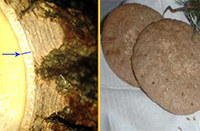 Bark Bread – is a bread made by adding inner bark (carries organic nutrients) to the flour as an extender to make it last longer, bake more breads and still keep them nutritious. In fact bark meal contains more zinc, magnesium and iron then is found in rye and wheat and it is full of fiber.
Bark Bread – is a bread made by adding inner bark (carries organic nutrients) to the flour as an extender to make it last longer, bake more breads and still keep them nutritious. In fact bark meal contains more zinc, magnesium and iron then is found in rye and wheat and it is full of fiber.
It was widely used during Norway famine, the Finland Famine and it was commonly eaten by our ancestors.
The bark component was usually made from trees like elm, ash, aspen, rowan, birch, pine and moss.
The inner bark is the only part of a tree trunk that is actually edible, the remaining bark and wood is made up of cellulose which no man can digest. The dried and ground inner bark was added: about 1/3rd “bark flour” to the remaining grain flour.
The bark, however, adds a rather bitter taste to the bread, and gives particularly white bread a grey-green hue. Though bark today is sometimes added to pastry as a culinary curiosity, bark bread is considered an emergency food, and as is common with such food, phased out as soon as the availability of grain improves and people forget about it.
During the Famines of Russia
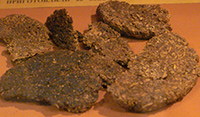
During famines in Russia, nettle and orache were used to make breads or soups (But you can also make polenta, pesto and purée). Chamiso and Shadscale (two species of orache) were also commonly eaten by Native Americans. Both rich in Vitamin E (much needed in a food crisis).
Nettle has a flavor similar to spinach (prepared in exactly the same way) when cooked and is rich in vitamins A, C, iron, potassium, manganese, and calcium. Soaking stinging nettles in water or cooking will remove the stinging chemicals from the plant.
Some breads were made out of orache and bran at the Siege of Leningrad, using machine oil – the only oil still available. (see picture) The city authorities provided the population with foodstuffs salvaged from industry. They made hard cakes of pressed seed hulls left over from processing of oil from sunflower, cotton, hemp or linseed. These seed cakes sustained many lives in Leningrad.
In France, Germany and Belgium During the Famine of WWI and WWII

Rutabagas were widely used as a food of last resort in Europe during the famine of World War I and World War II. The roots are prepared for human food in a variety of ways, and the leaves can be eaten as a leaf vegetable. Especially the French and the Germans boiled rutabaga making a stew.
During the Irish Famine
It is also called “The Potato Famine” since it was caused by a devastating potato disease (blight).
Corn meal sold for a few times more pennies a pound, so the men were unable to earn enough money to adequately feed themselves let alone their families as food prices continued to climb.
As a result, children sometimes went unfed so that parents could stay healthy enough to keep working for the desperately needed cash. Many of the workers, poorly clothed, malnourished and weakened by fever, fainted or even dropped dead on the spot.
As the Famine worsened, and looters became commonplace and the British continually sent in more troops instead of food.
The Irish in the countryside began to live off:
– Wild blackberries
– Ate Nettles
– Turnips
– Several species of edible kelp, including dulse and Irish moss
– Old cabbage leaves
– Edible seaweed
– Fungi
– Shellfish
– Roots
– Frogs
– Roadside weeds
– and even green grass
Finally, Government-sponsored soup kitchens were established throughout the countryside and began dispensing a nutritious food called Stirabout.
 ‘Stirabout,’ si a substantial porridge made from two-thirds Indian corn meal and one-third rice, cooked with water. By the summer, three million Irish were being kept alive on a pound of stirabout and a four-ounce slice of bread each day.
‘Stirabout,’ si a substantial porridge made from two-thirds Indian corn meal and one-third rice, cooked with water. By the summer, three million Irish were being kept alive on a pound of stirabout and a four-ounce slice of bread each day.
Seed potatoes, many having been eaten, had been in short supply. Planters had either been involved in the public works projects or had been too ill to dig the next year. Others were simply discouraged, knowing that whatever they grew would be seized by landowners, agents or middlemen as back payment for rent.
In a food crisis you can buy EVERYTHING with food.
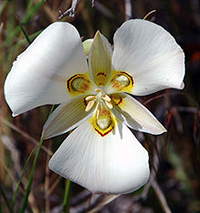 During the Mormon Famine in Western United States
During the Mormon Famine in Western United States
Sego lily bulbs were eaten by the Mormon pioneers when their food crops failed. The flower is endemic to the Western United States and it is actually the state flower of Utah. The bulbs of the flower were roasted, boiled or made into porridge. The plant was also eaten by Native Americans.
During the Dutch Famine
During the WWII the northern provinces became isolated from the liberated parts of Europe. Food stocks ran out, as did fuel stocks. Then a harsh winter began.
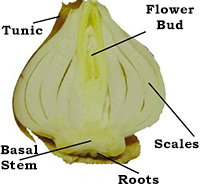 Due to the war situation, tulip growers have not planted tulip bulbs that year; great amounts of tulip bulbs were stocked on farms throughout the country. During the famine authorities decided to use these stocks as food for the starving populations. The tulip bulbs were nutritious and relatively easy to cook.
Due to the war situation, tulip growers have not planted tulip bulbs that year; great amounts of tulip bulbs were stocked on farms throughout the country. During the famine authorities decided to use these stocks as food for the starving populations. The tulip bulbs were nutritious and relatively easy to cook.
Here’s an account about how they prepared the bulbs (of one of the survivors – Father Leo):
“The skin of the bulb is removed, pretty much like an onion, and so is the center, because that is poisonous. Then it is dried and baked in the oven. My mother or older sisters would grind the bulbs to a meal-like consistency. Then they would mix the meal with water and salt, shape it like a meatloaf, and bake it. I can still remember the taste of it: like wet sawdust…We still shared tulip bulbs and sugar beets with those with hand-drawn carts who continued to go from door to door. I think seeing my mother still give to the hungry at this time, even though we had very little, made me want to be a missionary.” (Source)
They also boiled and ate Sugar beets. These are high in fiber, manganese, and is a decent source of vitamin C, potassium and magnesium. The greens, though, are really the nutritional powerhouse of the plant. They are super high in fiber, vitamin A, vitamin C, vitamin K, riboflavin, calcium, iron, magnesium, copper, manganese.
During most famines
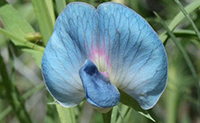 Grass pea is a particularly important crop in areas that are prone to drought and famine, and is thought of as an ‘insurance crop’ as it produces reliable yields when all other crops fail.
Grass pea is a particularly important crop in areas that are prone to drought and famine, and is thought of as an ‘insurance crop’ as it produces reliable yields when all other crops fail.
Well that’s something people eat when there’s nothing else to eat, because eating grass pea may cause a disease that basically paralyzes the lower limbs. The disease occurs only when the seeds are consumed as a primary protein source for a prolonged period but safe to eat for days maybe weeks.

When a famine occurs, that’s hell of a lot of people who end up eating this grass pea. The ratio is fairly small with about 10 out of 1000 people who get the disease.
Flour was made out of grass peas (named almorta) and they mixed it with wheat flour to eliminate the toxicity.
During Holodomor (The Ukrainian Famine)
For those faint-hearted: don’t read the next paragraph. You’ll find 3 real recollections of survivors from one of the most horrific famines. I wanted to include this in the article so people would better understand why and what do we prep for. And why having a food stockpile is an insurance you’ll not end up in this situation.
Olexandra Rafalska – one of the survivors – noted:
“…I have no idea how I managed to survive and stay alive. In 1933 we tried to survive the best we could. We collected grass, goose-foot, burdocks, rotten potatoes and made pancakes, soups from putrid beans or nettles.
Collected clay from the trees and ate it, ate sparrows, pigeons, cats, dead and live dogs. When there was still cattle, it was eaten first, then – the domestic animals. Some were eating their own children, I would have never been able to eat my child. One of our neighbors came home when her husband, suffering from severe starvation ate their own baby-daughter. This woman went crazy. “
Galina Smyrna, village Uspenka of Dniepropetrovsk region recollected:
“I remember Holodomor very well, but have no wish to recall it. There were so many people dying then. They were lying out in the streets, in the fields, floating in the flux. My uncle lived in Derevka – he died of hunger and my aunt went crazy – she ate her own child. At the time one couldn’t hear the dogs barking – they were all eaten up.”
A boy, 9 years old back then (later known as Dr M.M.):
“Mother said, ‘Save yourself, run to town.’ I turned back twice; I could not bear to leave my mother, but she begged and cried, and I finally went for good.”
Preparing for a food crisis or famine means preparing for at least one year. But famines can last up to 7 years and it can be wiser to have the means to produce your own food rather than stockpiling. One of the best ways to do that is by building a system totally independent from the environment.
And this CAN be done.
I have something you need to watch. It’s much better than I am at explaining the threat. Watch it and learn why you need your own sustainable food source and how you can build your own eco-system capable of producing food in any crisis.
You may also like:
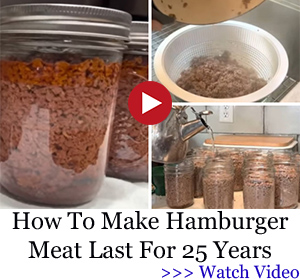 Read This Before Stockpiling Water In Blue Barrels
Read This Before Stockpiling Water In Blue Barrels
How to Build a Hidden Food Growing Fence in Your Backyard (Video)
50 Mistakes Even The Most Advanced Preppers Make

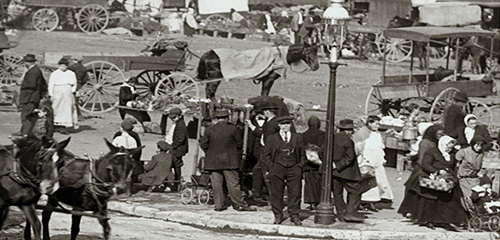




















Great article. Super important information here. Poignant at the end. Thank you.
Thank you. After I finished the article, I thought about posting it without the end. But I changed my mind. I thought that maybe it is better to show people what a famine really means: physically and emotionally. Those are REAL accounts. Thanks!
Those quotes about the famine in Ukraine were contained in a book entitled something like The History Of Ukraine.
The famine was a deliberate act of the communists in power in Moscow. Food was stripped from the countryside to feed the cities to prevent rioting in the cities. The communists figured it would be easier to put down riots in the countryside than in the city. I just finished reading that history book a couple of months back, so the quotes are very fresh. The communists tried to grow crops on grasslands that had from time immemorial only be used for grazing. The grasslands didn’t have enough soil nutrients nor enough water to support farm crops. The net result was there was no farm crop to speak of and there was also no animal husbandry as the animals had been killed off to plant the crops which didn’t grow. The peasants who had lived on the land for centuries knew crops wouldn’t grow but, of course, as with all bureaucrats, they knew better than the peasants. After all, they had college degrees in literature, political science, government, music, art . . .they knew better than the dumb, uneducated peasants who had been living on the land and thriving.
There is a lesson there, but government wonks won’t learn it.
I have used basswood Cambrian bark which looks like green spaghetti but tastes more like cucumber. I have eaten birch leaf sprouts–very good in a salad and not bitter. I haven’t heard during these famines that lasted years using syrup from birch or maple trees for a sugar. There must be more foods they found but not listed here–even swamp grass, reeds, cattails, rushes, grasshoppers, earthworms, snails, ants, bees, are edible. I would rather eat worms than eat a member of my family!
The more natural food you know, the better you survive.
Rats and mice thrive in urban environs. If you need protein consider these sources. If you live near oak trees, acorn meal was prepped by California Indians.and eaten seasonally.
Just remember, acorns have tannin, very bitter. Mash the acorns and let water drip through to leach out the tannins. California Indians did that and then could cook the mashed acorns as a filler in stews or as a type of bread.
Acorn soup tastes like pinto beans without salt. Roughly break the nuts, burry in wet sand along flowing water. In two or three days boil till tender.
Soajed @hroubd acorns can be cooked as b read patty thinky spread on a hot rock in the edge of a cooking fire. Some oak ashes mixed in act like a levening agent. Peel and eat or peel and boil whole.
Larger types of acorns can be peeled and eaten once they have over wintered and are turning pink ready to sprout. They turn sweet.
Great info, I am a natropath who makes no charge. Iwould love to have your wonderful book, however when it arrives into this country of Britain we will have to pay heavy taxes double than what your book costs!
Right now – as you read – North Koreans are out foraging for anything consumable …. grass clipping and peeling bark off of trees …..
Don’t think it can’t happen in the US …. your next meal is a truck delivery away ….
MORE TRU WORDS SPOKENNN…EVEN IN USA!!!..
thank you
Great article. It is a reminder that we are leaving in luxury at the moment.
We have a world wide food system. A shortage in one place is filled by an abundance in another.
But what happens if there is a solar flare and the power stops for weeks or months. Or the diesel that fuels our trucks stops because of shortage or war?
Not only can it happen again, it will happen again one day.
We actually learn about the sego lily bulbs here in history class. It’s why they made it the state flower and it became traditional in local art,out of thanks for the gift of the sego lily bulbs. I’ve always taken a bit of joy out of reading about the self-sufficiency that my Great Great Grandparents recorded in their journals and that they took the time to make sure that posterity could continue their knowledge and not suffer in the same way so many did. Thank you for telling the story of more survivors and letting us learn from them.
You should consider publishing/posting these journals. They sound interesting and helpful.
I am surprised they did not mention cattails . I though I read cattails were eaten a lot in Russia when times were tough.
Were they just eating the tails, or also the rest of the cats?
cattail roots, stems, and pollen are edible.
Your account of the iris famine is without fact, it was genocide. The British needed to clean up the land of its people, they needed it for food production to feed it’s ’empire’. There was no food available the British shipped it out and fought off the starving people from the gates of the port. The irish weren’t allowed on the beaches to fish the rocks were stripped clean of its seaweed. The British refused permission for forgian aid to come through. It was not famine but genocide.
partially correct, there was a blight and the British govt. was despicable, but many individuals were trying to help, e.g. protestants who opened soup kitchens attempting yo both feed and “convert” Irish catholics. Look up “souper” The British were also brutal to the Scots. Read OUTLANDER by Galbadon. Now we have to worry about ISIS who make old GB look like kitties.
Read the book “Paddy’s Lament” if you would like to learn about the Irish “potato famine”. A diet of potatoes with some mustard greens and the very occasional egg will provide enough trace minerals to stave off beriberi, scurvy, rickets and other nutritional deficiency conditions. I don’t remember the number of pounds of potatoes consumed a day by the Irish peasant, but it was an impressive amount. There was no market for potatoes at the time which is why they were available for food for the Irish peasant tenant farmer. When the blight hit, that food source was gone. Ireland was a net exporter of grain, meat and dairy products all during the famine year while the Irish tenant farmers starved.
A lesson I gleaned from a Norwegian lady, talking about the famine there (stories she heard as a child). Two children were found living off potatoes in a basement, after their parents died. They weren’t able to cook the potatoes. The lesson, **as best I can recall**, was that raw potatoes are edible, and that they may be more nutritious than coked.
Get the book “One Second After ” and it’s follow up ” One Year After” I got them on audiobooks from my library . It was an opener.
God sent the blight. The British caused the famine.
That is why anything I try to order from the USA they pileimpot customs tax
Thanks for the information. Having read the family journals of the early Oregon Pioneers from my side of the family and that of my wife’s there was we have little to add.
Those in the Willamette Valley did make soup from Doug Fir needles, what they added to it or supplemented it with wasn’t clear other than indigenous berries and game plentiful game. The winter after the Champoeg vote appeared to have been particularly harsh as my wife’s family overwintered in the Barn owned by F.X. Matthieu and consumed the Doug Fir tea or soup.
I too have Oregon Trail heritage; a Wagon Master who took pioneers West through the Willamette Valley and lived along what was called Totherow Bridge and the The Dalles. Solomon Totherow was on the Meeks Cut Off with
pioneers as well. It is an amazing ancestry and sure shows the strength of our ancestors who built this nation!! There are ancestors who still own the original land that some of the Totherows settled on and is now a golf course in the Bend area.
Jonathan Swift I believe made “The Modest Proposal”. Apparently he suggested folks eat their own young during the Irish potato famine. However, Swift was a writer and made that suggestion in one of his writings which was a protest against the British not helping alleviate the Famine in a timely manner. I have heard of a number of situations where people acted in a cannibalistic manner to keep from starving. The Donner Party in the Mountains at Donner Pass when they got trapped by a winter storm on their way across the Rockies. Other people have obviously done so too as noted in the article. It would be better to make some kind of provision for food storage or seed storage to assist personal survival in case of a SHTF situation.
The Donner Party was on the SW side of Lake Tahoe in the Sierras when an early storm hit.
I understand that flower wont last stored, and no answer was given why. I have a stored supply’s four two years for two now, and am dividing it up to put in different places and am growing veggies in my green house growing under fish growing tanks. I’m set for the long haul, if I can protect it from looters. at 78 its going to be a job.
All grains tend to contain eggs in their flours. The standard method of storing in their original sacks or ofjust putting them in buckets will not keep the eggs from hatching out and ruining the flour. Two things will give you a long shelf life on flour. What I use is breaking them up into half-gallon jars or FoodSaver gallon bags and sealing with the canning jar lid attachment to vacuum out the air. 2. Put a couple of the small oxygen remover packets in each jar or sack. There are very inexpensive on line in bulk amounts. For sealing a five gallon food grade bucket, put in about 1/4 of your flour and add 2 or e packets, another 1/4 and a couple more etc. ending with a couple of packets on top. Seal the bucket completely so that no new air can get in through the lid with silicone. I am expecting 15 to 20 year life on my grains. Once opened the process used will need to be repeated.
You can also successfully kill bugs and eggs by putting the sack of flour in your freezer for a week or more before putting it in buckets or mylar bags.
Actually weevils and other bugs in flour don’t ruin the flour. Read any tales of sailing voyages in the 17th, 18th, and 19th centuries and you will read about the weevils in the biscuits. Read accounts of the Nazi prison camps or the Japanese prison camps during WWII and you will read that the prisoners welcomed weevils and other insects in their gruel as it added protein to an otherwise protein-free diet. We are too fussy these days. It is good to be able to throw out five pounds of flour merely because it has weevils in it. In a different situation, five pounds of flour with weevils was better than five pounds of gold. If there was no food to buy the gold was worthless.
We always put bay leaves in flour and grains. It repels all bugs with a couple leaves per each ten lbs.
Also bay leave in with flours and grains keep critters out.
Is there a prepper in Dallas FtWorth area that knows of prepper meetings? Email me I am signed in with prosper.
Saw the paragraph on eating tulips. I’m glad they’re good to eat, apparently, but TAKE NOTE THAT DAFFODILS ARE POISONOUS!
Keep in mind that tulip bulbs are also poisonous unless prepared correctly. Please research before ever trying to eat them.
The tulip core is toxic. niio
Would like to receive info about “prepping”….. thanks
Just a note on garden flowers. I typed up a manuscript for a professor on various poisonous garden plants and was quite amazed at how many of the beautiful blossoms to be found in the garden would kill you if you tried to eat them! Also, some varieties of a plant, such as a daylilly are perfectly edible, while other lillies will do you in. Make sure you know what your doing!
Day lilies are not TRUE lilies. True lilies have leaves on the stalk with the flower. Daylilies do not have that feature.
https://www.thespruce.com/lilies-and-daylilies-1402798
Wild sunflowers seeds and lumpy roots are edible raw or cooked.
Daylilly bulbs and flowers are edible.
Violets flowers and leaves are edible.
Nasturtiums are edible.
Many others are edibles.
Wild cereal grains – oats, wheat, rye, corn, wild rice, rice grass, ….
It’s a matter of learning.
Some cacti and their fruits..
Nuts are great wild foods.
Many green plants are adible or drinkable as teas.
Some tree inner barks are edible.
Learn your area plants and what’s edible raw or cooked or makes tea.
Then there are wild medicinals……
Claud: Good reading. Every wannabe Marxist should be made to read the accounts of Stalin’s horrors.
Sago lily is drought tolerant. It prefers to grow in the shade of pines, and makes a nice bulb. Ajo (garlic) lily is another one.
Most things down in the desert must be cooked to be eatable. Ricegrass is a desert form of wild rice and likes deep, sandy soil. In warm area, wild maize will produce. Tepary beans will grow fast during the monsoons. Chia, Tarahumara is best north of the border. niio
Lambs quarters wild.
Better than spinach.
Ireland was completely surrounded by ocean…I don’t understand why they couldn’t catch enough fish to feed their families. Fishing is one of the most basic skills.
Harley: Fishing stocks are running low around the world.That’s why they want people to eat things like hagfish, a scavenger. No one wanted it. Same with beef brisket and flank steak. niio
The Holodomor in Ukraine killed many of my family members. It was intentional, political. Genocide. Much more than food was taken.
Why squirrels bury black (or red) oak acorns. They bury them because these nuts are so toxic in tannin and so on they would kill the squirrel. By spring the acorns are tannin free and when they begin to sprout, they’re high in sugar. the shell crumbles off so be careful not to allow the seedling to green or it develops tannin.
In areas where white oak (or blue or Englmann’s) won’t grow, people collected the bitter acorns and stored them in high humidity in underground grain bins. Some people buried them in pits. niio